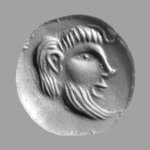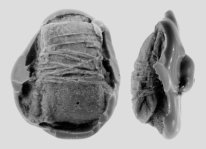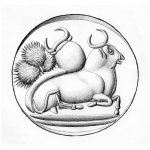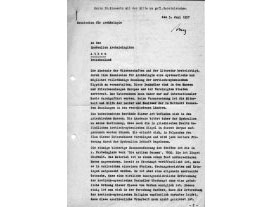The CMS Collections
Impressions/Casts
Seal intaglios are studied in positive, i.e. from their impressions. The reason for this is that the motif and the engraving technique in the impression can be discerned more clearly because they are not masked in any way by the colour and texture of the material used.
In the CMS archive impressions/casts of more than 12.000 different seal faces are available. These were either taken from the seals themselves or from ancient seal impressions. Impressions/casts of the backsides of sealings once attached to objects (thus taking the form of the objects) as well as those of ancient fingerprints on sealings are also kept in the archive (selected data). This comprehensive collection provides a unique opportunity for the researcher to undertaking comparative studies of Aegean glyptic material which is kept in collections all over the world.

Modern impression of the seal face of CMS I no. 5

Cast of the base of the sealing HMS 10/12
Materials used for the impressions/casts
The materials mainly used for the manufacture of impressions/casts are plasticine, silicon and gypsum. When documenting seals, plasticine is used for impressions of shallow to medium-deep intaglios whereas silicone is more appropriate for casting deep intaglios in which the plasticine cannot penetrate. Both these materials and silicon to an even greater degree are excellent for taking a positive from the intaglios, as they render the seal face so accurately that even the slightest scratches and the shine of the surface are perfectly reproduced.
In the case of sealings, both plasticine and silicon are used for taking impressions/casts of ancient seal impressions, the backsides of the sealings, and fingerprints on the clay. When working with sealings, plasticine is mainly used for smaller and silicon for larger surfaces.
Gypsum is employed for casting the impression/cast taken from ancient seal impressions. In this way, both the positive and the negative of the original seal face are available in the archive.
Photographs/Slides
A comprehensive collection of black and white as well as colour photographs/slides of all the objects for which impressions/casts are available and of the impressions/casts themselves is kept in the archive (ca. 100.000 negatives).
Drawings
Drawings reproducing the seal face as it is seen in its impression and thus in relief are available for all seals published in the CMS series. The drawings are rendered employing fine shading with pencil.

Drawing of the seal face of CMS V Suppl. 1B no. 111

Letter of F. Matz to the Kentrikon Archaeologikon Symvoulion (1957)
Information
Index cards with information on every piece handled by CMS scholars are available at the archive. These cards constitute a kind of ID for each piece as they record its characteristics in detail. In addition, they contain unpublished notes recording the opinions of the respective scholars on problematic aspects of the various pieces, such as the material of the seal.
Mineralogical collection
A comprehensive collection of stones and minerals from all over the world is kept at the archive.
Reproductions
A reproduction of an Aegean bow lathe as well as replicas of Aegean seals/sealings constitute indispensable teaching tools.
Archival material on the history of the CMS
Many artefacts kept at the archive tell the story of the beginning and development of the project: letters of correspondence dating to the very start of the CMS project; the notebooks of the first scholars working for the CMS; the PC in which the first version of the CMS Databases was drafted and saved; posters and images created for exhibitions held by the CMS Marburg.


